Look for Metallic Green Sweat Bees Visiting Your Garden This Fall
Metallic green bees are a genus of bees (Agapostemon) that mate over winter underground and then emerge in spring to establish new nests. After finding a new nesting site, females begin collecting pollen and nectar from flowering plants in late May or early June. Males and females are active in the summer and fall, foraging on some of the last flowering plants of the season, including asters and goldenrods.
These beautiful, brilliant green bees are medium-size and visit a wide variety of open flower forms. Unlike some other bee genera that visit only specific plants, metallic green sweat bees do not but often demonstrate a preference for flowering plants in the large plant family Asteraceae. By providing composite flowers (those in the Asteraceae family) and flowers that provide forage for the first females that emerge in late spring, you will have many metallic green sweat bees visiting your garden throughout the growing season.
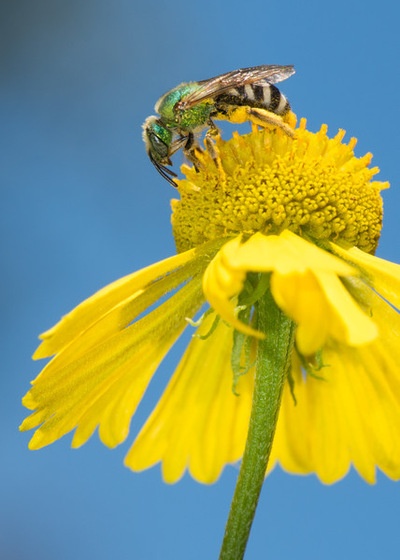
Family: Halictidae
Subfamily: Halictinae
Genus: Agapostemon
Numbers: Approximately 14 species and two subgenera in North America (north of Mexico); four species east of the Mississippi; 44 species worldwide
Distribution: Metallic green sweat bees are found in the western hemisphere from central North America south to Central America and parts of South America
Habitat: Woodland edges, gardens, meadows, prairies, old fields and farms
Shown: A female metallic green sweat bee (Agapostemon virescens) on sneezeweed (Helenium autumnale)
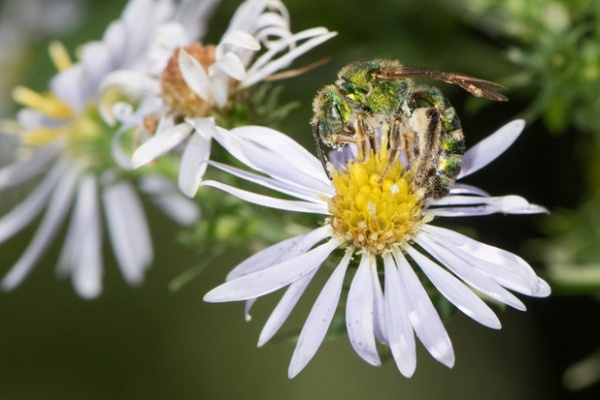
When to look for them: In the northern United States, mid to late May is often when some of the first sightings of female Agapostemon occur, earlier in the spring farther south. There are no known plant specializations with this bee genus; females (and males) visit a wide variety of flowering plants, often plants in the Asteraceae family.
Shown: A female metallic green sweat bee visiting crooked stem aster (Symphyotrichum prenanthoides) in late summer
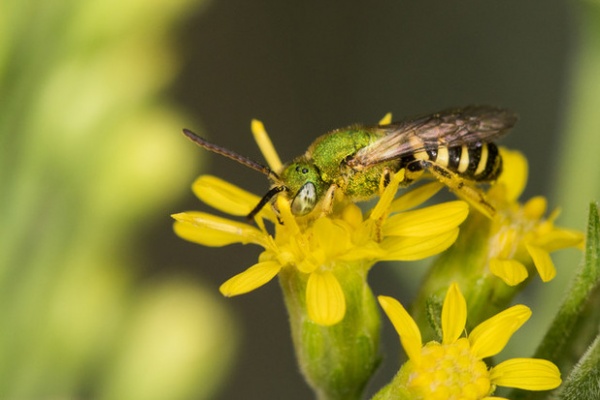
How They Help
Metallic green sweat bees are effective pollinators, visiting a wide variety of open or accessible flowers from early summer through fall. Their medium size, narrow form and relatively long tongue allow them to access flowers that are somewhat complex or slightly closed in form.
Like all bees, metallic green sweat bees need a continuous succession of flowers in the garden and a variety of flower forms and colors. Females expend a lot of energy during nest building and provisioning, and thus require an ongoing supply of pollen and nectar to fuel their activities, as well as to provide food for their offspring.
Shown: A male metallic green sweat bee visiting stiff goldenrod (Oligoneuron rigidum)
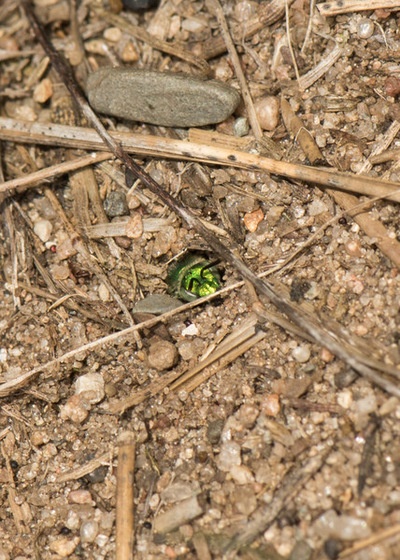
How to Spot Metallic Green Sweat Bees
Adults: These beautiful bees are hard to miss with their bright metallic green coloration.
Metallic green sweat bees vary in size; the smaller species are approximately ¼ inch (7 millimeters) long, and the largest are ½ inch (13 millimeters) long. Adults have a long, narrow shape with a bright emerald green head and thorax. Agapostemon virescens females have a black abdomen with white bands; all other females have a metallic green abdomen with or without white bands.
All males look similar, with a metallic green head and thorax, and a black abdomen with cream or yellow bands. Males also have yellow legs with black markings and no pollen-collecting hairs on the hind legs. Males’ antennae often appear thicker than females’ antennae. Males are common in midsummer through autumn, emerging from the secondary nest produced in a season.
Babies (larvae): Larvae are grub-like and are pale yellow to cream in color. It’s uncommon to see larvae, as metallic green bees nest below ground.
Shown: A female peeking out from her nest entrance in sandy, bare soil near the Mississippi River in central Minnesota
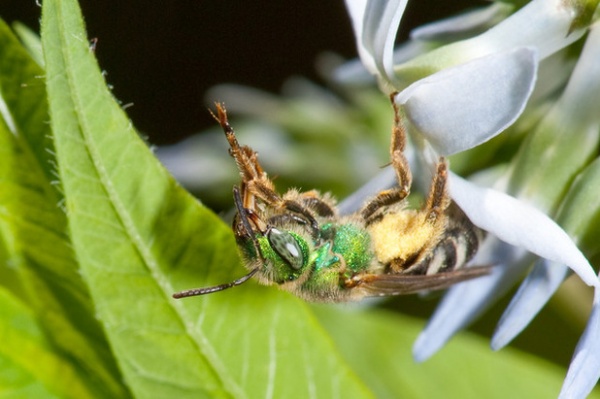
How to Lure Them
Provide a nesting place. Besides maintaining a pesticide-free garden and continuous succession of flowering plants, you’ll need a place where metallic green sweat bees can nest. All Agapostemon nest in the ground; some species demonstrate a preference for sandy, sandy-loam or loamy-sand soils. Uncompacted bare soil is ideal to provide an adoptable site for nest initiation and excavation for females. Nest construction typically begins in late spring or early summer.
Nests often occur in large aggregations, with many nests clustered together in close proximity. A. virescens, A. cockerelli and A. texanus have been found to nest communally, with multiple females sharing a nest but provisioning and laying eggs in their own excavated brood cells. It’s important to look for bees excavating nests in your landscape, especially in sites where the soil is bare, and protect the site from disturbance.
Maintain a bee-safe yard. Do not use pesticides, especially insecticides, in the garden, particularly on flowering plants.
Shown: A female metallic green sweat bee (A. virescens) cleaning her tongue after visiting eastern bluestar (Amsonia tabernaemontana)
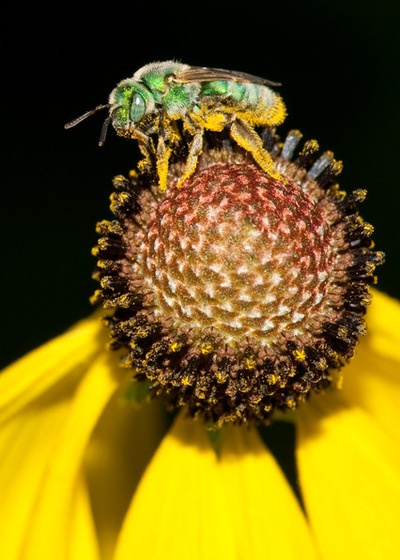
Offer forage plants for adults. After emerging from their overwintering site and initiating a nest in the ground, female metallic green sweat bees begin collecting pollen and nectar in late spring and early summer. Foraging by females and, later, males continues through the summer and into the fall.
Sample plant list for adults:
Late spring: Spiderwort (Tradescantia spp.), Canada anemone (Anemone canadensis), pale purple coneflower (Echinacea pallida), beardtongue (Penstemon spp.) and dogwood (Cornus spp.)Summer: Gray-headed coneflower (Ratibida pinnata), black-eyed Susan (Rudbeckia spp.), coneflower (Echinacea spp.), purple prairie clover (Dalea purpurea), wild quinine (Parthenium integrifolium), ironweed (Vernonia spp.), vervain (Verbena spp.), smooth oxeye (Heliopsis helianthoides) and cup plant (Silphium spp.)Late summer and fall: Goldenrod (Solidago spp.), common boneset (Eupatorium perfoliatum) and asters (any species)Browse native plants for your region
Shown: A female metallic green sweat bee visiting a gray-headed coneflower
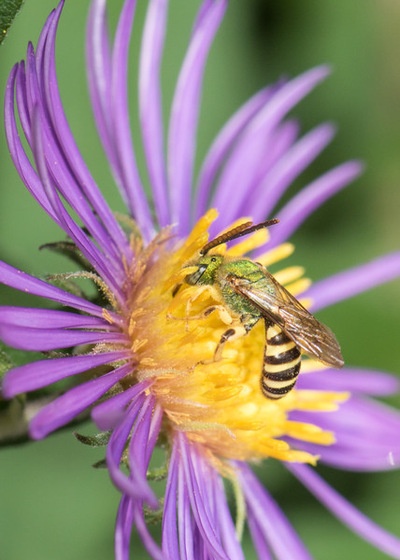
Life cycle. In the upper Midwest, Great Lakes and Northeast regions, metallic green sweat bees have either one or two generations per year. Nests of species that produce one or two generations are established by females that have mated in the fall, overwintered, then emerged to establish a nest the following spring. Depending on the species, nests can occur singly, in aggregations or communally, with multiple females sharing a nest.
For species that produce one generation per year, both male and female offspring are produced, and these bees begin to emerge from the nest in late July, foraging into early October. The females mate with males and, in the fall, find a place below ground to overwinter.
For species that produce two generations per year, the first generation produced in the nest is predominantly females. The daughters emerge as adults and establish a nest; many do not mate with males, so the majority of their offspring are male (unfertilized eggs). The offspring from the second generation forage into fall. Any active females mate with males, then overwinter underground. All the males perish at the end of the season.
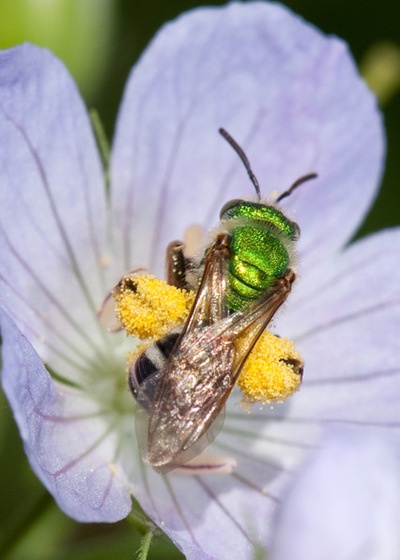
Females excavate their nests by burrowing into the ground. From this burrow, lateral brood cells are excavated, where the female deposits pollen and nectar that she has collected from flowers. These floral resources are combined to form a pollen ball (bee bread), and when enough pollen and nectar have been collected for a given brood cell, the female lays an egg on the provisions and then caps the cell with soil. The capped brood cell is backfilled with soil, often with soil excavated for the next brood cell above in the nest.
Region by region: What to do in your garden this month












